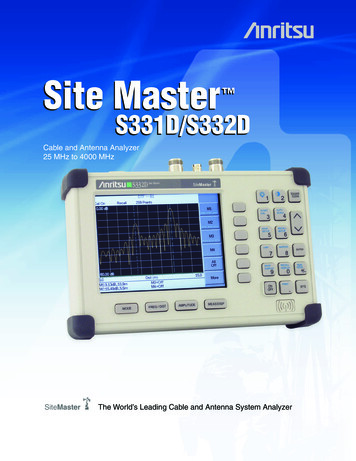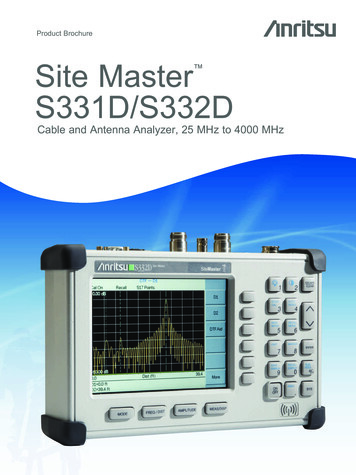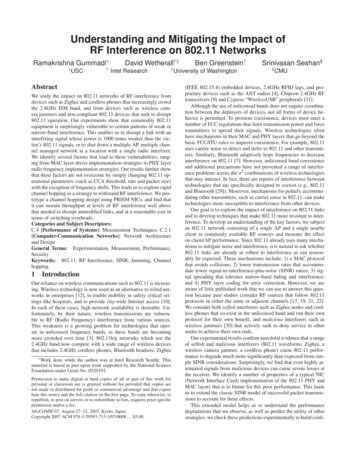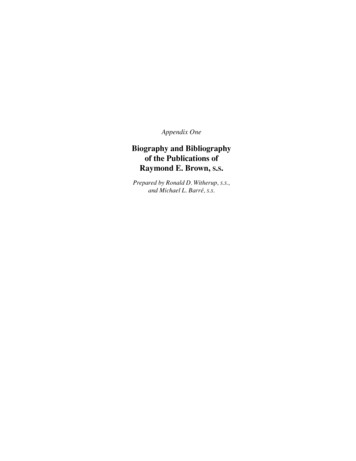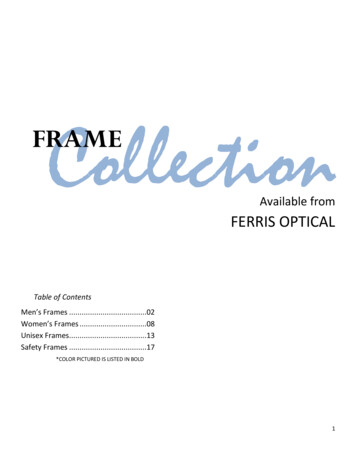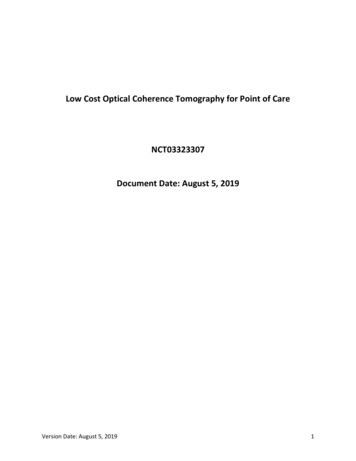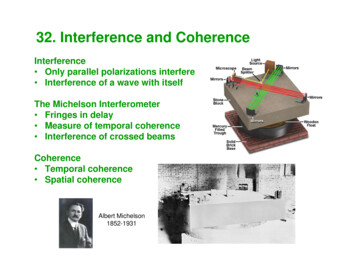
Transcription
32. Interference and CoherenceInterference Only parallel polarizations interfere Interference of a wave with itselfThe Michelson Interferometer Fringes in delay Measure of temporal coherence Interference of crossed beamsCoherence Temporal coherence Spatial coherenceAlbert Michelson1852-1931
Orthogonal polarizations don’t interfere.The most general plane-wave electric field is: E r , t Re E0 exp j (k r t ) where the amplitude is both complex and a vector: E0 E0 x , E0 y , E0 z The irradiance is:don’t forget the complexconjugation!c * c *** I E0 E0 E0 x E0 x E0 y E0 y E0 z E0 z 22
Orthogonal polarizations don’t interfere (cont’d)Because the irradiance is given by:c * c ***I E0 E0 E0 x E0 x E0 y E0 y E0 z E0 z 22combining two waves of different polarizations is different from combiningwaves of the same polarization.Different polarizations (e.g., x and y):I c E1x E1x* E2 y E2 y* I1 I 2 2 Same polarizations (e.g. both have x polarization):*c c * I Etotal , x Etotal , x E1, x E2, x E1, x E2, x 22 Therefore:I I1 I 2 c Re E1 E2* This is what iscalled a “cross term.”This cross term can give rise to very dramatic effects.
The irradiance when combining a beam witha delayed replica of itself has “fringes.” I I1 c Re E1 E2 I 2*Suppose the two beams are E0 exp(j t) and E0 exp[j t )].That is, a monochromatic wave and itself delayed by some time :I 2 I 0 c Re E0 exp[ j t ] E0* exp[ j (t )] 2 I 0 c Re E0 exp[ j ]2 2 I 0 c E0 cos[ ]2Fringes (as a function of delay)II 2 I 0 1 cos[ ] - How do we vary the delay of a beam?
Varying the delay on purposeSimply moving a mirror can vary the delay of a beam by manywavelengths.Inputbeam E(t)MirrorOutputbeam E(t– )Translation stageMoving a mirror backward by a distance L yields a delay of: 2 L /cNote the factor of 2.Light must travel the extra distanceto the mirror—and back!Since light travels 300 µm per ps in air, 300 µm of mirror displacementyields a delay of 2 ps. Delays of less than 0.1 fsec (10-16 sec) can begenerated using this technique.
We can also vary the delay usinga mirror pair or a corner cube.Mirror pairs involve tworeflections and displacethe return beam in space:But out-of-plane tilt yieldsa nonparallel return beam.E(t)MirrorsE(t– )InputbeamOutputbeamTranslation stageCorner cubes involve three reflections and also displace the returnbeam in space. Even better, they always yield a parallel return beam:[EdmundScientific]
The Michelson InterferometerinputbeamThe Michelson Interferometer splits abeam into two and then recombines mirrorthem at the same beam splitter.outputbeamsplitterdelaySuppose the input beam is a plane wave.Then the intensity measured at the output is: mirror Iout I 1 I2 c Re E0 exp j( t kz kL1) E0 exp j( t kz kL2 ) I0 I0 2I0 Re exp jk(L2 L1) 2I0 1 cos(k L) *since I0 I1 I2 (c 0 / 2) E0IoutFringes (as a function of delay): L L2 – L12
The Michelson Interferometer - clarificationIout 2I0 1 cos(k L) If the path length difference is zero, this becomes:Iout 4I0Are we getting more photons at the output than we put in? No!inputbeammirroroutputbeamsplitterdelaymirrorIn this expression, the symbol I0 refersto the intensity in either one of the twobeams at this location.But both beams that reach this pointhave passed through the 50/50 beamsplitter twice, thus reducing their intensity(relative to the intensity of the inputbeam) by a factor of 4.Thus:I0 Iin 4
The Michelson-Morley experimentto measure the aether“The most famous failed experiment of all time”The Aether WindAlbert ternUniversity, 1887Nobel Prize, 1907 (first American to win one of the science prizes)
Interference of crossed beams k k cos zˆ k sin xˆk k cos zˆ k sin xˆ k x k r k cos z k sin x k r k cos z k sin xz k * I 2 I 0 c Re E0 exp[ j ( t k r )]E0 exp[ j ( t k r )] Cross term is proportional to: Re E0 exp j t kz cos kx sin E0 exp j t kz cos kx sin Re exp 2 jkx sin cos(2kx sin )*Fringes (as a function of x position)Iout(x)x
Big angle: small fringes.Small angle: big fringes.position 2 /(2k sin ) /(2sin )As the angle decreases tozero, the fringes becomelarger and larger, until finally, at 0, the intensity patternbecomes constant.Small angle:positionThe fringe spacing, :Large angle:
You can't see the spatial fringes unlessthe beam angle is very small!The fringe spacing is: /(2sin ) 0.1 mm is about the minimum fringe spacing you can seewith the naked eye: sin /(2 ) 0.5 m / 200 m 1/ 400 rad 0.15
The MichelsonInterferometer(Misaligned)Inputbeamx MirrorzBeamsplitterSuppose we misalign the mirrors,so the beams cross at an angleMirrorwhen they recombine at the beamsplitter. And we won't scan the delay, so the lengths are equal.If the input beam is a plane wave, the cross term becomes: Re E0 exp j t kz cos kx sin E0 exp j t kz cos kx sin * Re exp 2 jkx sin cos(2kx sin )Fringes (in position)Iout(x)Crossing beams maps delayonto position If the path length difference changes, the fringes shift.x
The Michelson Interferometer:A questionLet’s go back, for now, to thewell-aligned plitter L L2 – L1 largeIf we move the moveable mirrorfurther and further back, do wecontinue to see fringes forever?If not, then how far can we gobefore they disappear?Iout 2I0 1 cos(k L) delaymirror
The Temporal Coherence Time andthe Spatial Coherence LengthThe temporal coherence time is the time over which the beam wavefronts remain equally spaced. Or, equivalently, over which the fieldremains sinusoidal with a given wavelength:The spatial coherence length is the distance over which the beam wavefronts remain flat:Since there are twotransverse dimensions,we could talk about twodifferent coherencelengths. Instead, wedefine a coherence area.
SpatialandTemporalCoherenceBeams can becoherent or onlypartially coherent(or, even incoherent)in both space and intime.Spatial herenceSpatialCoherence;TemporalIncoherenceSpatial andTemporalIncoherence
The coherence time of monochromatic lightA nearly monochromatic light source has a large coherence time:E-fieldampitudetimeIf we know there isa maximum here.and we wait a time equal to.then we know that wean integer number of periods. will find another maximum.For a perfect cosine, the integer could be as large as you want(up to infinity), and this would still be true.Thus, an ideal monochromatic light source has an infinite coherence time.In the real world: highly stabilized lasers can have coherence times onthe order of a few seconds. That’s amazing! More than 1015 cycles!
The coherence time of polychromatic lightA polychromatic light source has a smaller coherence time.Here’s an example: an E-field composed of a superposition of severalmonochromatic waves, each with a slightly different frequency.1234567 8 9 1011 12131415272616171819Start at thismaximum.Wait N periods,where N 1, 2, 3, .2025242321 22What is the value of the E-fieldat each successive value of N?Is it still a local maximum?The coherence time for a given waveform is the average amount of timeone has to wait from an arbitrary starting point before coherence is lost.
What determines the coherence time?sum of 3sine wavesE fieldS( )timeS( )E fieldsum of 5sine waves time E fieldsum of 10sine wavesS( )time More spectral components more rapid loss of coherence
The coherence time is the reciprocal ofthe bandwidth.The coherence time is given by: c 1/ vwhere is the light bandwidth (the width of the spectrum).Sunlight is temporally very incoherent because its bandwidthis very large (the entire visible spectrum).123456Short optical pulses also havesmall coherence times, roughlyequal to their duration.“Coherence length” (c0/n) c
Why are we interested in coherence time?Because the notion is relevant to measurements that we often do. Letus suppose that we take a wave and interfere it with a copy of itself:a wavea time-delayedreplica of thesame waveIf the time delay is zero ( 0): perfect constructive interference at every point.The net irradiance is large.If the time delay is half the period ( ): nearly perfect destructive interferenceat every point. The net irradiance is zero.If the time delay is the period ( 2 ): constructive interference at everypoint. The net irradiance is large.
What if the delay time is large?at this time, constructive interferencedestructive interference herea wavea time-delayedreplica of thesame wavetime delay If the time delay is large ( c): There is no correlation between the peaks ofthe wave and the peaks of the time-delayed version. Interference is sometimesconstructive, sometimes destructive. The net irradiance no longer depends onthe delay .Interferogram: the pattern formed by the net irradiance as a function of delay.Why is this interesting? One reason: because interferograms are easy tomeasure using a Michelson interferometer.
32. Interference and Coherence Interference Only parallel polarizations interfere Interference of a wave with itself The Michelson Interferometer Fringes in delay Measure of temporal coherence Interference of crossed beams Coherence Temporal coherence Spatial coherence Albert Michelson 1852-1931
